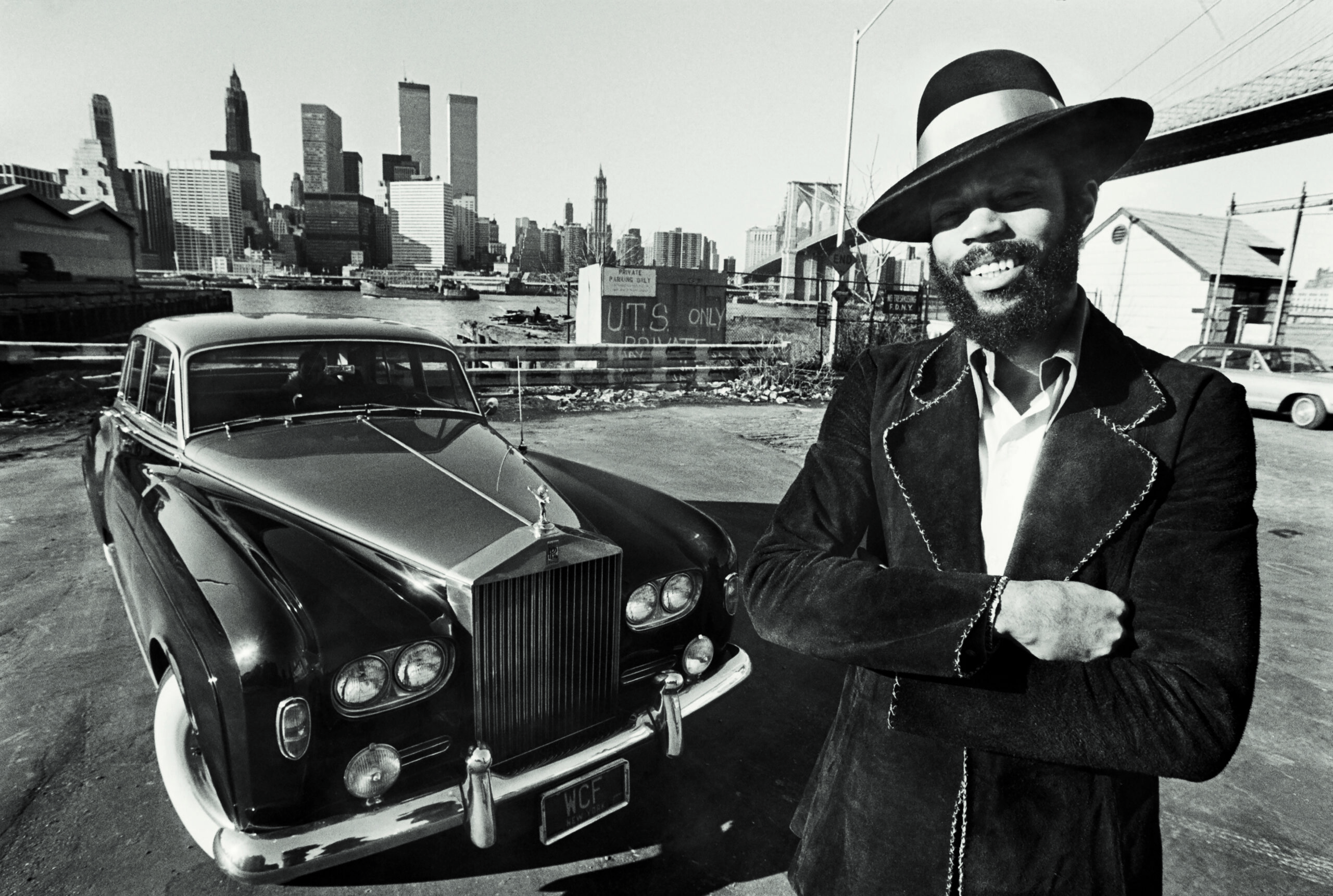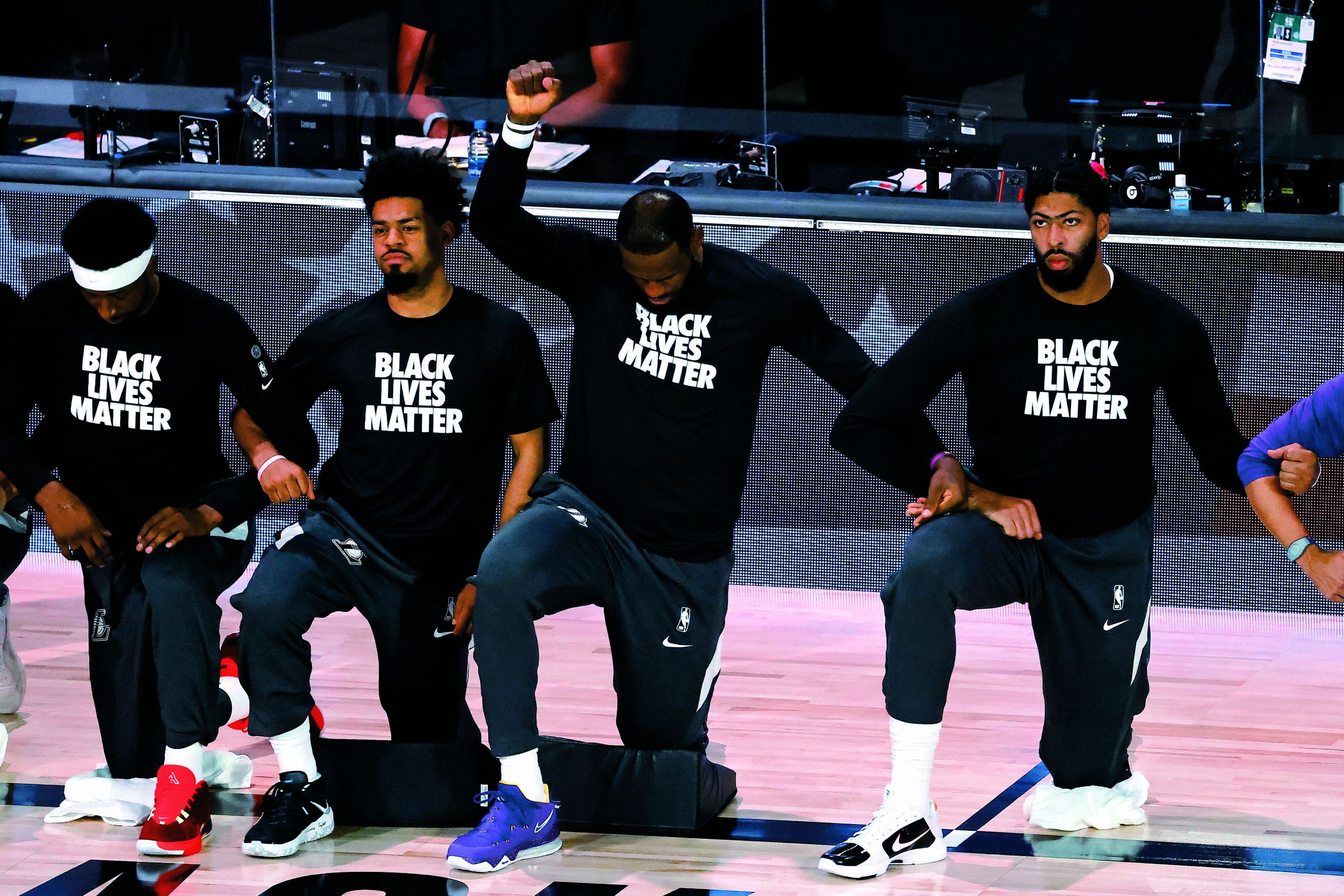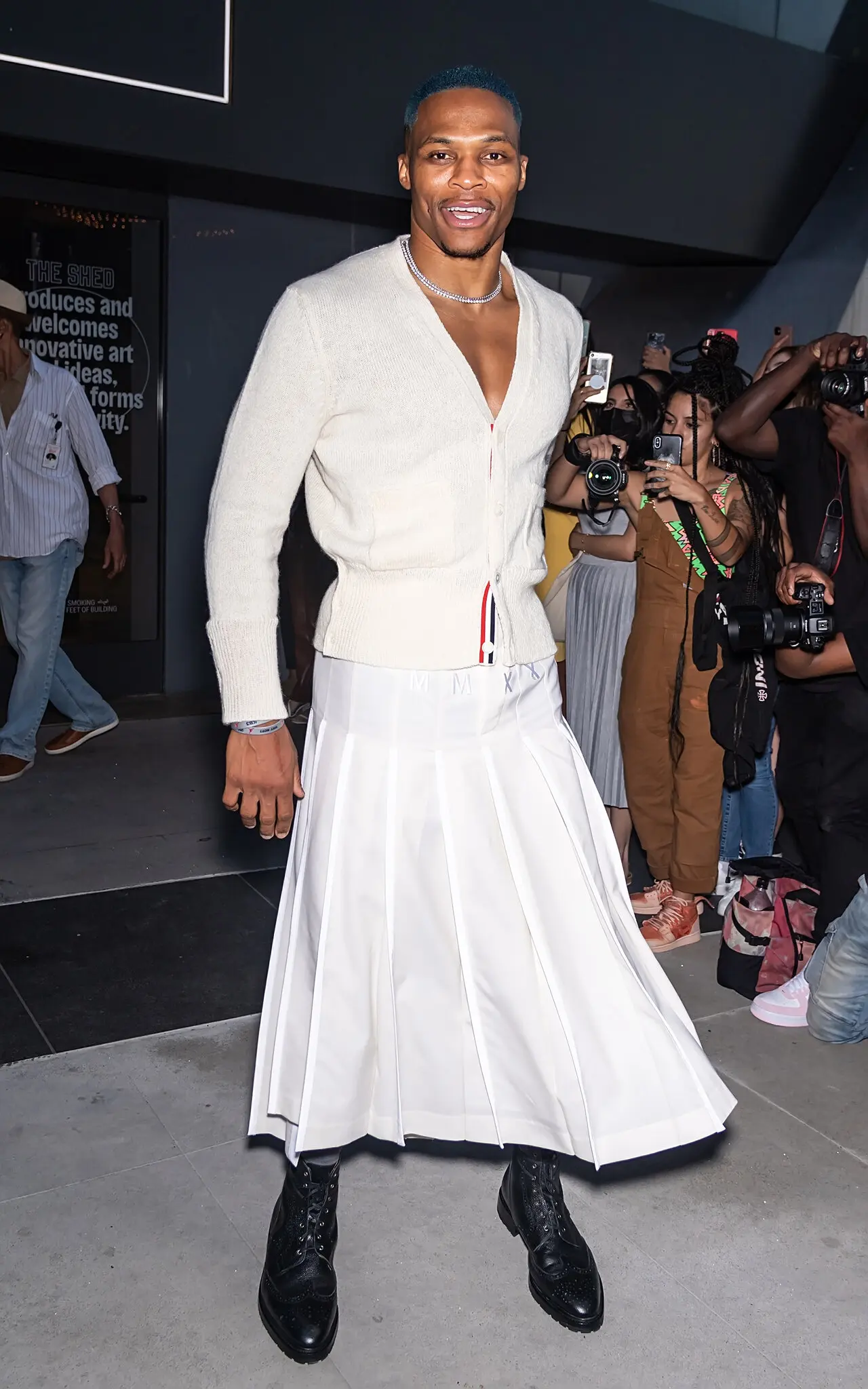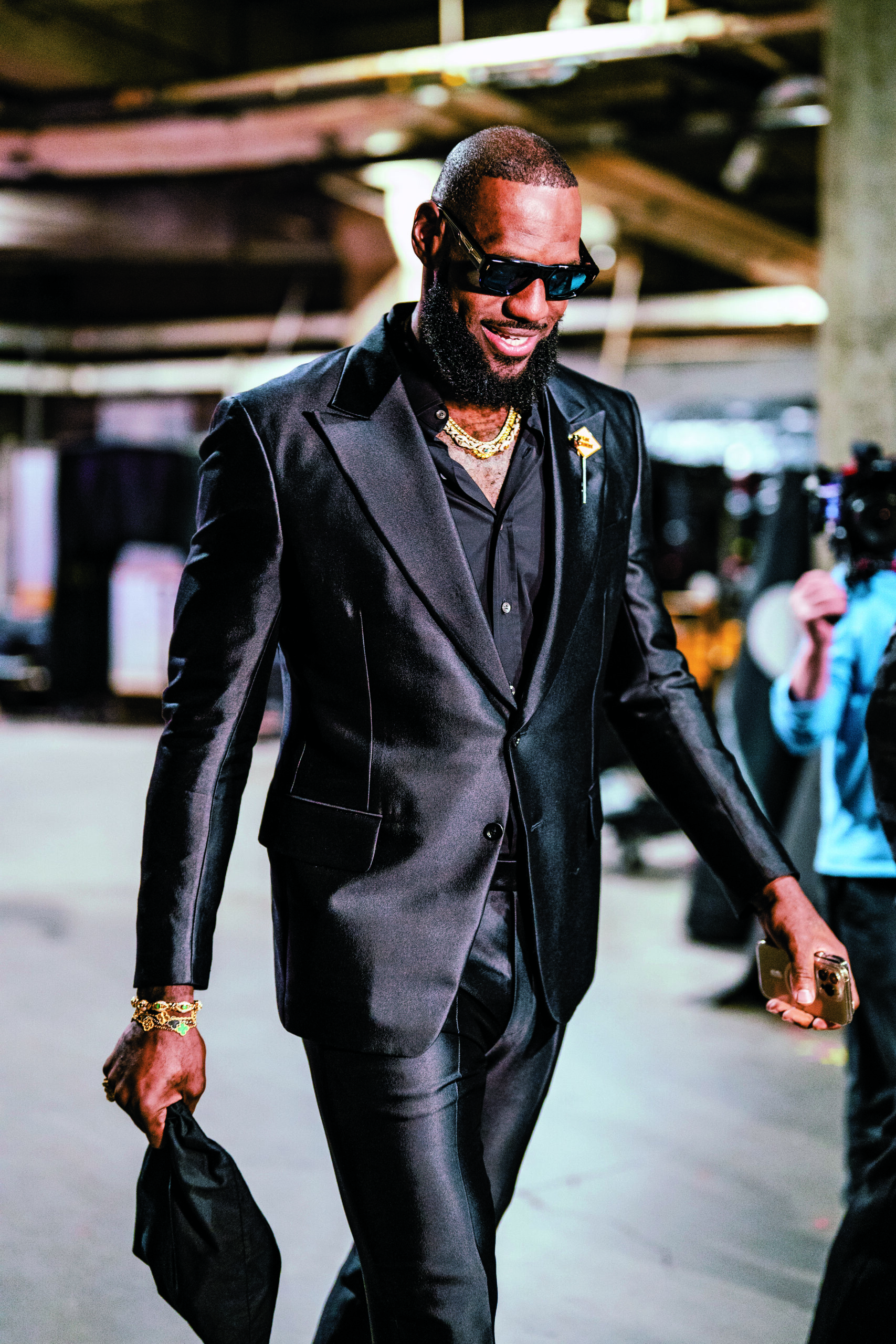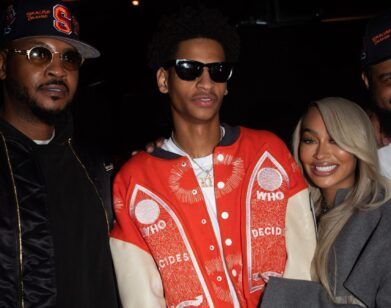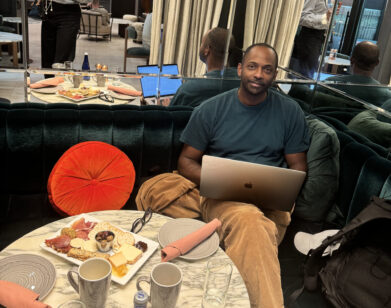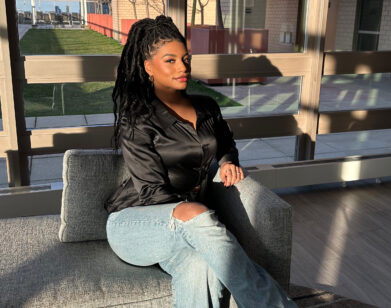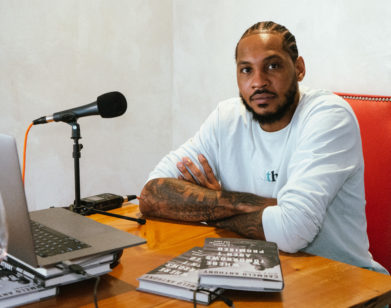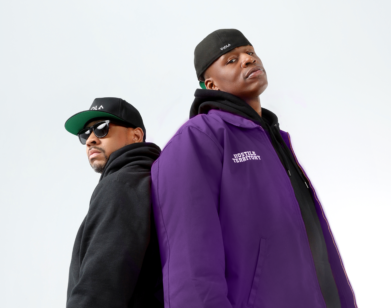BALL
Mitchell Jackson on Jordan, NBA Fashion, and What It Means to Be Fly
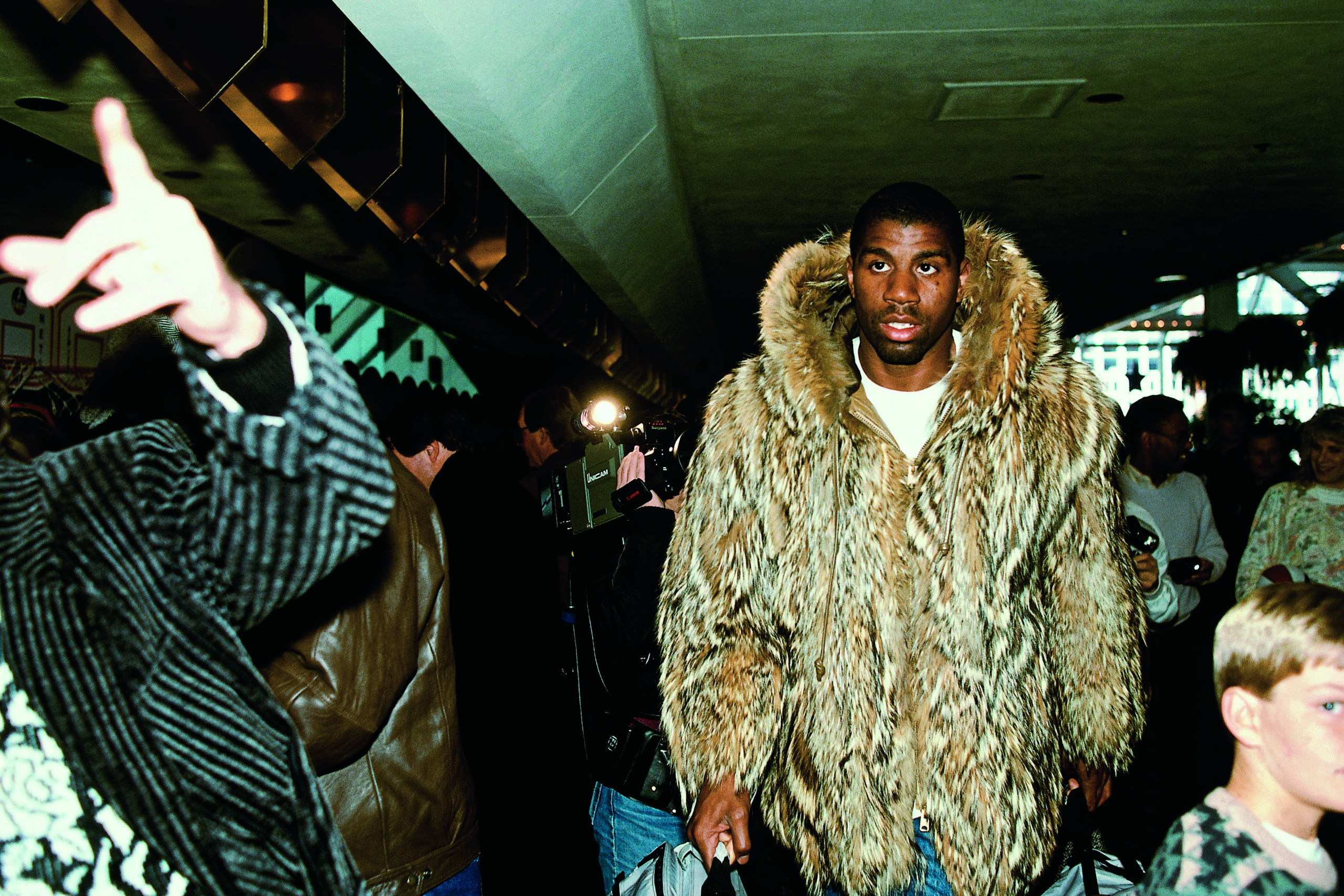
Earvin “Magic” Johnson #32 of the Los Angeles Lakers arrives at the arena before the 1988 NBA All-Star Game on February 7, 1988 in Chicago, Illinois. Copyright 1988 NBAE (Photo by Andrew D. Bernstein/NBAE via Getty Images)
Style, writes Mitchell Jackson in the introduction to his new book Fly: The Big Book of Basketball Fashion, is “Magic Johnson fast-breaking in The Forum with his signature high dribble and legerdemaining defenders with a wide-eyed lookaway.” It’s Steph Curry sinking threes from preposterous lengths; it’s Kareem Abdul Jabbar’s signature skyhook. That Jackson, a Pulitzer Prize-winning essayist, opted to write an enormous coffee table book about the intersection of basketball and fashion in particular speaks to the ways the NBA, more than any other professional sports league, has become a site of individualism, a league that respects its players politics, one where they feel free to roll up to the arena in mink or head-to-toe Thom Browne. Before the publication of Fly, out today from Artisan Books, Jackson got on Zoom with us to parse the meaning of “fly,” the crossover between basketball and hip hop, and declare, once and for all, his All-NBA fashion starting five.
———
JAKE NEVINS: Hey there, Mitchell.
MITCHELL JACKSON: Hey, what’s happening?
NEVINS: I’m doing well. Congratulations on Fly, which I tore through in one sitting. What made you want to write a large coffee table book that’s also a history of NBA fashion and, in some ways, Americans politics, too?
JACKSON: Man, I wish I could take credit for the idea. The publisher of Workman was friends with my editor at Esquire and brought the idea to him. I guess her husband is a basketball fan, and he brought it to me knowing that I love fashion and am also a huge basketball fan. It just seemed like a great thing to do, and very timely. But I will say that I took it on thinking, “Oh, man, this is a couple months worth of work, we in and out.”
NEVINS: That doesn’t sound quite right.
JACKSON: I’m like, “This is a long feature story.” Nah, this is not a long feature.
NEVINS: Well, it’s a very satisfying read, partly because of how comprehensive it is. You start with this riff on style—not as it pertains to fashion, but basketball. Is there something about the sport you see as particularly conducive to individualism?
JACKSON: Yeah. So one of my favorite quotes about style is Miles Davis, “You got to have style in everything you do.” I think that’s a particularly relevant quote in basketball. You don’t just make a layup; you finger-roll a layup. I remember when I was young, people started dunking without pulling the rim down. Shawn Kemp, I think, really started this. So, to me, I don’t know how you could be that conscious of the way in which you’re stylizing your play and then not be [stylish] in other areas of your life. So I really like that. Another Miles Davis quote, not to turn this into a jazz thing, is, “You got to play a long time to sound like yourself.” I think that’s also connected to style. You’ve got to have a bunch of misses. I just had a miss over the weekend. I was out of the country, and I was like, “Oh, this is a miss.” But you’ve got to have some misses.
NEVINS: Where were you?
JACKSON: I was in Madrid. There’s a lot of fashionable people in Madrid, too, so the miss hurt even more, because I felt the context of my miss all around me.
NEVINS: Well, I follow you on Instagram. You have drip. It was interesting reading Fly alongside your recent Esquire piece commemorating 50 years of hip hop. You write, “Hip-hop fashion has always been aspirational, about willing an ascent.” I suppose the same could be said about NBA fashion.
JACKSON: Oh, yeah. When I began working on this book, I initially wanted to arrange it by decades. Luckily, I had a good editor who said, “No, decades are too arbitrary and they don’t really define moments.” So then I had to start thinking, “What are the moments, political, historical, cultural, that are defining these shifts? What are the shifts?” Certainly, hip hop is one of those, and to me, hip hop fashion and NBA fashion are damn near synonymous, because they’re the same guys. The average hip hop guy is around the same age as the average NBA player. Sometimes they’re friends. They’ve come out of the same neighborhoods. They’ve played at the same Boys and Girls Clubs, so they had the same influences. When I talk about hip hop being about aspiration, I think Jordan, in that era, really codified that idea of aspirational living. Then hip hop, when it hit its heyday in the mid-’90s and early 2000s, when Puffy was riding on a yacht and Jay-Z films “Big Pimpin’” on a big ass boat, now they’re also showing us what it looks like to be aspirational.
NEVINS: Well, in Fly, you write about how the earliest NBA fashion was about respectability, about Black players fashioning themselves in a certain way to appease white folks. Is there a similar era in hip hop?
JACKSON: I think hip hop is a renegade form from its beginning, and that era that you’re talking about predates hip hop. When hip hop was born 50 years ago, we’re post-civil rights, where Blaxploitation is happening, we’re getting Walt Clyde Frazier. So I think it makes perfect sense that hip hop started off as a counterculture. The early hip hop dudes were really just wearing the same thing that the dudes in the gangs were wearing. It never had to conform, I guess we can say.
NEVINS: You mentioned that your editor discouraged you from arranging this book by decade. Instead, you divvy it up by eras: “The Conformists,” “Flamboyance,” “Jordan,” “Iverson,” and so on. How did you go about distinguishing them?
JACKSON: Well, I had the advantage of living through most of the eras, right?
NEVINS: Right. I didn’t, though I did have two goldfish growing up named Iverson and Vince Carter.
JACKSON: Where are you from?
NEVINS: Baltimore.
JACKSON: Oh, you’re not a Melo fan?
NEVINS: I’m a big Melo fan, but we no longer have a pro team back home, so as a kid I’d sort of pick and choose my favorites at random. But anyway, back to you.
JACKSON: Well, I think I had the most trouble with the early ones, and that’s because I had to do the most research. Something that was satisfying about this book was that I had to go into a sport that I had played half of my life, but I didn’t know… I couldn’t have told you when the NBA was founded. And I’d heard of [George] Mikan, but I didn’t know he was the first star. I think the average NBA fan might not know this kind of historical context, how they had these other leagues going before they actually became an association. Then, once I got into the Jordan era, I’m like, “Now we’re talking. I watched that game on my couch.” But you can’t just take your experience for granted, so I still had to do a lot more research. So, yeah, it took a little something different for each era, but I think that those middle ones, when I was around, it was easier to pinpoint who were the players. And it’s not just who was good, it’s who was good and who was fly, and that’s a different conversation.
NEVINS: Speaking from my own experience, as someone who’s a fan but also writes about sports, it can be hard to sublimate your own bias. I’m not sure who your favorites players are, but did you find them creeping into the book?
JACKSON: Well, luckily, the guys that I liked were the fliest. So that was very helpful. I’ll put it like this, right? And this is no disrespect. I like this dude. I think he’s a tremendous player. But Dame Lillard. And I’m from Portland. I’m a Trail Blazers fan. But on that team, Jerami Grant is the fashionista. There’s not a doubt. Going by basketball, if you ask me who’s the best basketball player on the Trail Blazers, that’s unquestionable. But when we’re saying, “Who’s fly on the team?” you’ve got to give it to Jerami Grant. As journalists, we’ve got to be able to take a step back. It’s like, I like Joe Montana, but Tom Brady is better than him.
NEVINS: Sure. So I’m curious what you make of the recent spate of NBA documentaries and docuseries, and the degree to which that kind of supports the thesis of your book, of the NBA as the epicenter of flyness. I follow the NFL quite closely, but I think among a certain set of people, it’s a bit unseemly to do so. So how big of a part does fashion play in the NBA’s becoming—
JACKSON: The cool league?
NEVINS: Pretty much.
JACKSON: Yeah. One, I think the NBA is the most savvy of the marketers of their product. They figure out what their players love, they figure out what we love about their players, and they lean into that in a way that other leagues don’t do, or don’t do as quickly. I remember when George Floyd happened. Which was the last league to say something? And which was the first league to say something? Which league allowed their players to kneel? So it’s not just fashion. It’s that they are getting behind their players in a way that other leagues don’t. I also feel like part of it is that the players have more power. Their contracts are generally bigger. Their contracts are guaranteed. I used to argue about this when I was young. I’m like, “Man, I don’t want to play football because I want the women to see my face. I don’t want to have a helmet on for the whole game.” Notice how, when an NFL player really wants the spotlight, they’ll snatch their helmet off.
NEVINS: Right, and then they’ll get a penalty for it.
JACKSON: Exactly. So, in the NBA, you ain’t got to worry about snatching off no helmet, man. But I think a lot of credit is due to the league for recognizing their players’ interests. I don’t think it’s just benevolence. I think the players force that. LeBron’s “decision” forced the league open. Now star players have just as much power, or damn near it, as GMs. I wrote a column on baseball a few months ago, and baseball has had an initiative to staunch the bleeding of American Black players for 30 years, and it’s still not happening. Black kids in the hood are not playing baseball. Baseball is not cool, for whatever reason. But I think they are still playing basketball. I was just watching on Facebook that they had a high school tournament at Rucker Park [in Harlem]. I have yet to see something like that for baseball.
NEVINS: Right. And your note about the NBA as a greater site of individualism is a nice segue. In the book, you spoke to a woman who styles many of the players. You asked her to characterize this current era in NBA fashion and she described it as “risk-taking.” You see that when Russell Westbrook wears a kilt, or in some of Ja Morant’s outfits, the way both of them are subverting traditional notions of masculinity, which I find refreshing.
JACKSON: I would say we can’t divorce this from our evolution in thinking about gender, right? And thank god we have had this discourse now, this political movement, this cultural movement. I also would say that we should thank hip hop. To have guys like ASAP Rocky and Kid Cudi and Kanye pushing against the boundaries of masculinity. So now we get a Jordan Clarkson painting his nails, or Westbrook wearing the Thom Browne kilt. I think they’re looking towards hip hop, and vice versa, to see how far we can push against these boundaries. Dennis Rodman was doing this years ago, but I feel like Dennis Rodman was doing it for the shock of it back then.
NEVINS: Always with a wink.
JACKSON: Yeah, exactly. But now I feel like this is an acceptable part of our culture and our humanity, really.
NEVINS: It’s cool to imagine a young kid who might want to experiment with fashion but fears getting made fun of in school. And nothing gives them more license to play around with clothing than some of the greatest athletes in the world strolling into the arena in a Thom Browne kilt.
JACKSON: Shout out to Westbrook, though.
NEVINS: Okay, besides Nike, is there one brand you consider most important in the evolution of NBA fashion?
JACKSON: Well, the answer is Nike, but in terms of high fashion, I’m going to say Thom Browne. That moment where the Cavs came through all dressed in Thom Browne, we don’t get to this version of the tunnel walk without that. So, in terms of a brand that’s not Nike or Adidas, that’s the one.
NEVINS: What’s your All-NBA fashion starting five?
JACKSON: Ooh. All right. My starting five, in no order. I’m putting ‘Bron in there because, to me, ‘Bron dresses like who he is, possibly the greatest NBA basketball player ever. I think that outfit he wore the night he broke Kareem’s record is a very good example of dressing like who you are in the world. I think you’ve got to put Westbrook in there. I’m not actually a huge Westbrook fashion fan, but I respect the risks that he’s taken. I’ve got to put my guy Wilt in there. It’s hard to be fly at seven feet, but Wilt was fly. And you can’t do it without having Walt Frazier in there. That’s a given. So I got one more. I’m going to pick a current guy. Let me see. I am going to put P. J. Tucker in there. P. J. is a streetwear god.
NEVINS: I think you covered all the positions, too. Or maybe we need one more guard. But anyway, which player has had the greatest influence on your own style?
JACKSON: Man, it’s crazy. I just turned 48 last week, so I’m not really looking to them like that. He’s probably 26 or something, but I think Jerami Grant. He’s kind of bohemian. I really like Margiela myself. It feels like he’s really cultivated his own look. But I also really like D’Angelo Russell, because he’s a cool, preppy dude. Really, nobody else is doing what D’Angelo Russell is doing. Cultural and edgy is Jerami, and then today I’ve got to go teach a class, so Professor Mitch is like D’Angelo Russell.
NEVINS: D’Angelo’s got cool style. Well, thanks Mitch, this was a pleasure. Congratulations on the book.
JACKSON: Thank you. I appreciate it.

